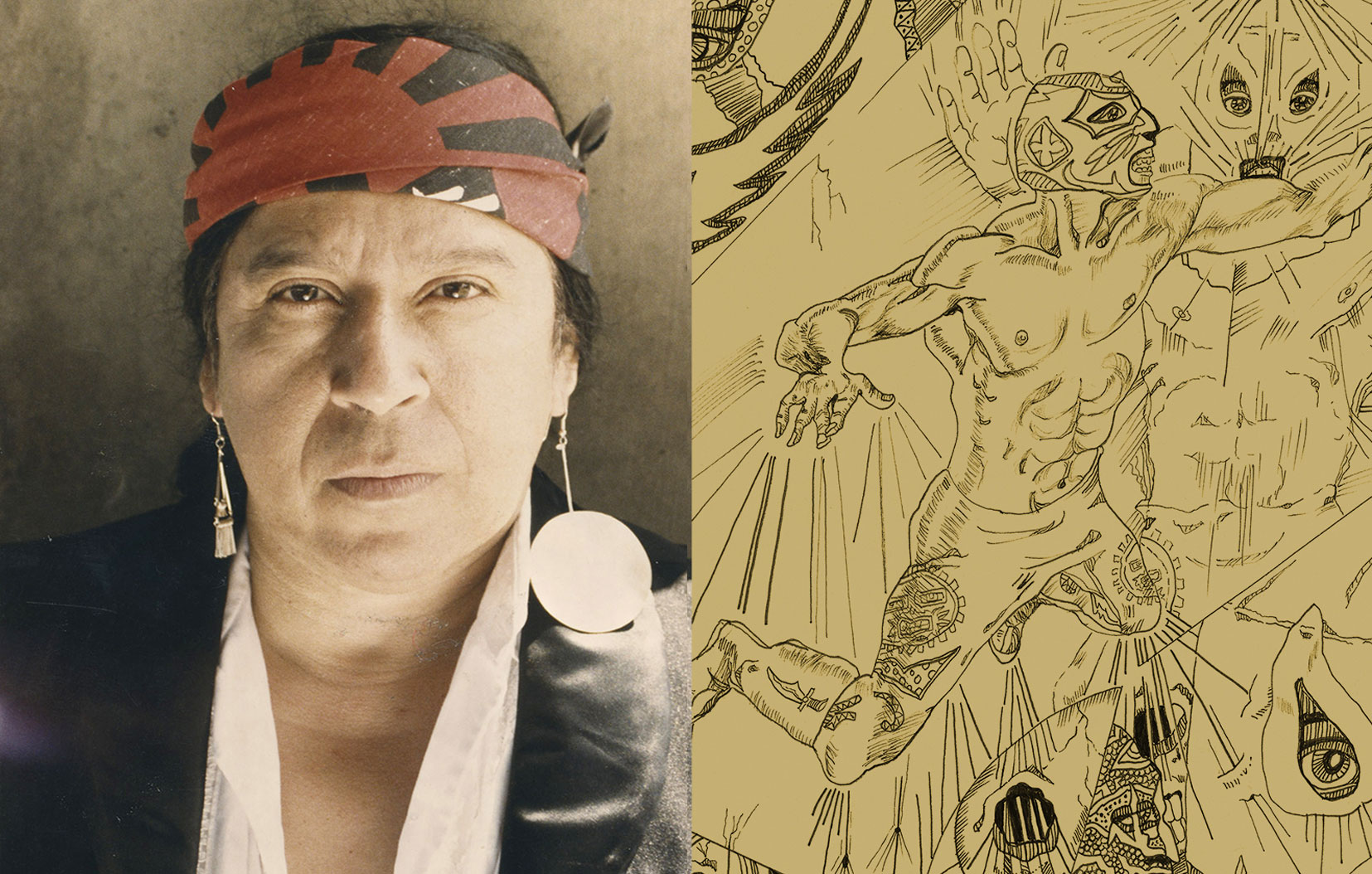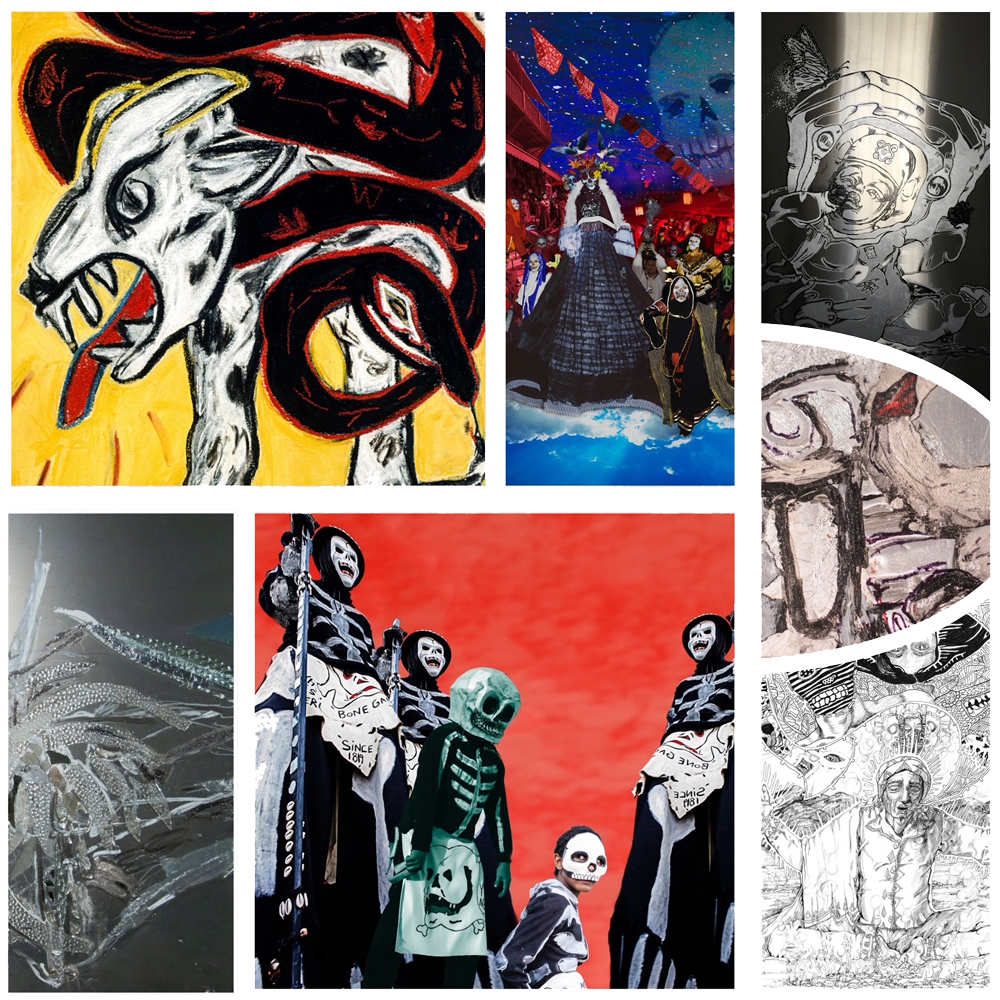- Tables
- Chairs
- All Furniture
- Search
- Email Us
- 1 (818) 478-1444

Opening Exhibition Saturday, February 8th from 12pm to 8pm
Wednesday – Sunday from 3pm to 8pm
View by Appointment Available – Please call or email
Show runs thru March 3rd
More than an art show, this Exhibition is an experience of Los Angeles’ cultural history of theater, performances, songs, art and more.
“I have not seen anything like in my 20 year career specializing in hanging fine art through out Socal. It is uniquely original”
Held at Ambience Doré, celebrating 25 years in business, Open Arms is a retrospective show featuring two artists whose symbiotic lives have been dedicated to art and creative exploration.
Foremost, this powerful exhibition showcases the life and fascinating career of Native American Latino SoCal playwright, producer, and artist Josef Rodriguez White Cloud, who goes by “Doc,” and contemporary visual artist Mar Doré, known as M3.
Doc's "When Quasars Suck and Black Holes Blow,” “Songs of the Singing Glyphs” and “Wormholes Rock in Dead Tattoos” depict alternative realities of ethnic life: lucha libre figures, mythic cultural symbols, a mother earth figure, and skulls moving through the multiple wormholes of alternate parallel worlds.
During the show, guests will take a step back in history to see grassroots theater and hear songs with lyrics and scripts still pertinent to today’s time. You’ll find a fascinating story of how Doc emerged from the farming community in Fowler, California. In high school, he won the National Forensics’ Original Oratory Championship in 1962, which led to more opportunities.
Six years later, Doc produced one of the first minority-written plays, “El Manco,” in American Theater at the Los Angeles Inner City Cultural Center in 1968. From there, Doc worked with Luiz Valdez in the early ‘70s in San Juan Bautista with his Native America version of “La Virgen de Tepeyac.” In the San Francisco Bay Area, Doc performed and created theater, including work at the Hatley Martin Gallery.
Doc carried on the tradition of the theater through his 1992 production of “The Get Lost Again Columbus Opera,” premiering for the National Indigenous People’s Days Protest in Berkeley. Written in history as the first Native American Opera, you can discover the full history in person, including his new Sci-Fi Opera script, at the Open Arms Exhibit.
Doc and Mar traveled to Indigenous communities. Doc was instrumental in connecting Engineers Without Borders to the Indigenous community of Nueva Catalina De Ixtahuacan, Guatemala. The community was relocated after mudslides from Hurricane Mitch.
The combined art of the two is charged with an unspoken energy. Doc’s theatrical performances, scripts, drawings, paintings, and photos are juxtaposed with M3’s abstract contemporary sculptural wall art in metal, rock, and mixed media—from large pieces to small handheld wearable art.
M3, an MFA graduate of the San Francisco Art Institute, is premiering her original Metal Giest series of 3D paintings and contemporary explorations. This art has been intentionally kept off the internet and out of public exposure. For M3, it represents a lifetime of development and discovery.
Recently, Doc has experienced some medical issues that inspired M3 to celebrate his life through the Open Arms exhibit.

"I want Doc to feel honored for his creative life's work. Now is the time for him to shine. We welcome all with open arms to see the work and be inspired to celebrate your own history, try new things, and keep dreaming.”

White Cloud “Doc” grew up in Fresno, CA 1943. His parents Jose and Delores Rodriguez were Spanish-speaking Mexican immigrants. He often worked in the fields instead of going to school until his sisters convinced his parents of his exceptional talent.
In High School he excelled from a freshman through senior years, winning many awards, including the 1962 National Forensic Championship for original oratory with his script “The Plea” written at age 14. This set him up with scholarships that led to more opportunities, including the Pasadena Playhouse where he produced his play “Invocation at Golden Gate Bridge.”

He won a Shubert Playwrite scholarship to attend Occidental College. In 1968, Doc’s play was one of the first minority plays featured in American Theater. He wrote and starred in “El Manco” (1968) at the Inner City Cultural Center, Los Angeles. Betty Saar did the costume design for his main character. Doc was ahead of his times and had to persevere through typecasting roles available to minorities and theater companies afraid to produce some of his works, as they considered them too shocking.
Doc worked with Luiz Valdez and Peter Brook and directed Valdez’s theater troupe in Doc’s indigenous version of El Virgin De Tepeyac in the early 70s at the San Juan Batista Church. He worked with and directed Jay Silverheels’ Indian Actors Workshop in Los Angeles. At the Pasadena Playhouse, he shared the stage with Sally Struthers, Imogene Coca, Marni Nixon, and Bea Lillie. He performed in Steve Allen’s experimental science fiction dramas in the early 1960s and co-starred with Jay Silverheels in “Eagle Boy.”
His colleagues in Los Angeles included cinematographer-turned-director John Alonzo, Tom Smothers, Brian De Palma, Katherine Ross, and Orson Welles. He starred in “Hotspur” for Olympic Films International and worked with Patty Duke and Richard Boone in “Deadly Harvest.”
He co-founded the Napa Valley Theater Company in Yountville, CA, and produced “El Vato Loco” (misquoted by the newspaper as “Bato Loco”). He produced “Alice in Wonderland” and “Antigone,” with Betty Saar working on the productions.
In the Bay Area of San Francisco, White Cloud produced many performances and one-man shows, including “Toltec in Deco Land” performed at the Hatley Martin Gallery in San Francisco. He was ahead of his times and had to persevere through typecasting roles and theater companies afraid to produce some of his works, as they considered them too shocking.
In the early 1990s, in the Bay Area, White Cloud started working on the “Get Lost Columbus Opera” and produced it in October of 1992 as part of the local protest to Columbus Day. The New York Times hailed it as the first Native American opera, coinciding with Berkeley declaring National Indigenous Peoples Day on October 12, 1992.
Doc’s works go beyond writing, producing, singing, and scripts for film, theater, and TV. He connected with the Indigenous community of Ixtahuacan, Guatemala, through his study of the K’iche language from 2000–2008. He was instrumental in getting Engineers Without Borders to bring water down from the mountaintop to the newly relocated village below.
Doc traveled to meet and connect with other Indigenous communities, including those in Tibet, India, Tahiti, Mexico, and Guatemala. Doc is an accomplished artist in drawing and painting. He also enjoyed photography. Doc found fluidity and expressive freedom in any medium that he applied himself to.
The last of his artworks were pen and ink drawings and the “Singing Glyphs” story murals on stainless steel, depicting alternative realities. At the same time, he recorded six songs with local musicians in and around Pasadena, CA, from 2018–2019.